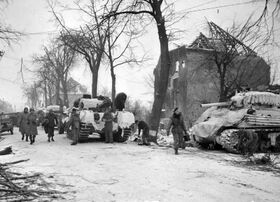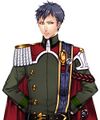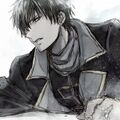November Offensive: Difference between revisions
BattlerNonna (talk | contribs) mNo edit summary |
BattlerNonna (talk | contribs) mNo edit summary |
||
| (2 intermediate revisions by the same user not shown) | |||
| Line 55: | Line 55: | ||
{{flagicon image|Realm_of_New_Akiba_3rd_Version.jpg|22px}} [[2nd Division (New Akiba)|2nd New Akiba Division]]<br/> | {{flagicon image|Realm_of_New_Akiba_3rd_Version.jpg|22px}} [[2nd Division (New Akiba)|2nd New Akiba Division]]<br/> | ||
| units2 = {{plainlist| | | units2 = {{plainlist| | ||
* {{flagicon image|Quen minh 691036.jpg|22px}} [[105th Infantry Division]] | * {{flagicon image|Quen minh 691036.jpg|22px}} [[105th Infantry Division (IQA) (Eordisverse)|105th Infantry Division "White Berry"]] | ||
* {{flagicon image|Quen minh 691036.jpg|22px}} [[91st "Iron Claw" Division]] | * {{flagicon image|Quen minh 691036.jpg|22px}} [[91st "Iron Claw" Division]] | ||
* {{flagicon image|Quen minh 691036.jpg|22px}} [[55th "Emperor's Youth" Division]] | * {{flagicon image|Quen minh 691036.jpg|22px}} [[55th "Emperor's Youth" Division]] | ||
Latest revision as of 22:00, 11 May 2024
This article is incomplete because it is pending further input from participants, or it is a work-in-progress by one author. Please comment on this article's talk page to share your input, comments and questions. Note: To contribute to this article, you may need to seek help from the author(s) of this page. |
The November Offensive (2 November - 31 December 1943) was an allied operation during the Third Joyonghean-Quenminese War which was aimed to penetrate further through Central Joyonghea by means of the Inje-Chuncheon Road and to capture the city of Chuncheon, which was the first major city in Central Joyonghea. The offensive was to be one of the bloodiest battles ever fought in the theatre, with both sides pitting their best units and weapons to control a vital town of strategic importance.
As early as 1942, Grand General Cheon Sang-ji had designated Chuncheon as the next most important city in the country, being that this was where the road and railway routes converged from all cities in Joyonghea. He believed that whoever controlled Chuncheon will keep his troops fed and supplied for a long time. When the Quenminese captured the town in 1938, it subsequently hastened their conquests of nearly the entire Joyonghean peninsula by the end of 1939. Hanamura left the capture of the town to General Albert Crocker, who ordered Generals Chae Hwa-young and Edward Samegawa to advance along the Inje-Chuncheon Road. The Imperial forces established key defensive lines along the road from Inje to Chuncheon, which the Allies had trouble penetrating into. When the Allies engaged with the defenders at Inje, they fought in an urban house-to-house setting, which the Allies had trouble securing into. Crocker then decided to cut off Inje from the chance of supply by surrounding the town in an ambitious move that defeated attempts by the Imperials to reinforce the town.
After taking Inje in 28 November, the Allies moved along the route to Chuncheon. Spearheading the attacks was Chae and her Joyonghean troops. As with Inje, they also had trouble traversing the route, with the Quenminese carrying out guerrilla-style warfare that harassed Allied columns along the route. Chae moved to destroy several outposts and defensive positions along the line. Although this was effective, the Imperials continued to hammer down on the Allies. By 16 December, Chae's forces had advanced too far from the main column that he found herself along with 3 Joyonghean battalions cut-off. The 39th Mactongese Infantry Regiment and 178th Infantry Regiment surrounded the Joyongheans, which allowed Marshal Quoc to move the Steel Tigers in to destroy the unit and halt the Allied push. To counter this, Crocker ordered several Engineer battalions to enact scorched earth policy along the route, which effectively burned out the defenders along the area. In addition, he sent in units of paratroopers to paradrop behind enemy lines and cause chaos. Despite these, advance was still slow, which meant that the Chae and the rest of the Joyongheans were at the mercy of Marshal Quoc. It wasn't until 19 December, when ZANAC forces moved along the route in a race to relieve Hwa-young's forces. They also employed scorched-earth tactics that burned out many Imperial nests along the way. The ZANACs were able to relieve the Joyongheans by 20 December with General Chae safe. Samegawa's forces relieved the battered Joyonghean forces and subsequently cleared the path to Chuncheon, ending the Allied march to the city by 22 December.
Crocker launched Operation Pine, which was the Allied operation to capture the city of Chuncheon. The tide turned in favour of the Allies by Christmas Day, when ZANAC forces stormed Joyonghea's biggest railroad station at the time. This gave Samegawa the ability to direct attacks on the defenders at multiple areas. Crocker ably supported him by attacking Marshal Quoc's western flank and subsequently defeating an Archadian attempt to reinforce the Quenminese in the city. By 30 December, the Imperials had exhausted all possible efforts to keep the city and were forced to retreat further north as Chuncheon fell to the Allies that night.
The capture of Chuncheon was a major success for the Allies, as nearly 50% of Joyonghea had finally been liberated. The Allies rested for a few months until 15 days later, when Allied units consisting of Teulabians, Rubrumians, and Jutlanders landed on Joyonghea's eastern seaboard at Pyongtaek.
Background
Order of Battle
| Key Quenminese Commanders | ||||||
|---|---|---|---|---|---|---|
|











